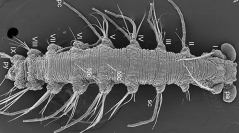

 European Journal of Taxonomy
1021 (1) - Pages 1-54
European Journal of Taxonomy
1021 (1) - Pages 1-54Nerillidae is the most species-rich, meiofaunal, annelid family, but little is known about its diversity and distribution in the Northwest Pacific. Four sampling campaigns to Jeju Island, South Korea, and the Ryukyu Islands, Japan, retrieved an unexpectedly high diversity of about 17 nerillid species in subtidal and submarine cave localities of the East China sea, with only Nipponerilla irabuensis Worsaae, Hansen & Fujita in Worsaae et al., 2021 previously described. Bayesian inference and maximum likelihood methods were performed on datasets of concatenated gene sequences (18S rRNA, 28S rRNA, COI, and H3) comprising a total of 55 terminals from 11 different genera of Nerillidae. Integrating detailed morphological assessments (light-, scanning electron-, and confocal laser scanning microscopy) with molecular analyses, we here describe seven new species and a new genus, Cirrinerilla gen. nov. None of the species show geographical overlap between South Korea and the Ryukyu Islands, possibly due to oceanographic and anchialine dispersal barriers and poor dispersal capabilities of Nerillidae. However, two congeneric terminals of Meganerilla and two of Leptonerilla from different islands of the Ryukyus show relatively high molecular similarity, suggesting recent vicariance of these populations (or species). The anchialine caves hold a remarkably high diversity of nerillids compared to coastal subtidal localities, supporting a preadaptation of Nerillidae to these isolated habitats under freshwater influence. This study underlines the need for further exploration of the unique anchialine habitats as well as additional subtidal meiofauna surveys in the East China Sea, for shedding further light on benthic diversifications and colonizations in this region.
Interstitial, hidden biodiversity, Stygobiota, molecular phylogeny, evolution